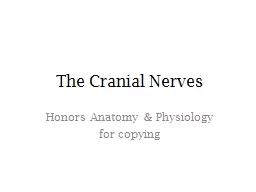

for copying CRANIAL NERVES 12pair named cranial because each passes thru a foramina of the cranium part of PNS each with roman numeral order from anterior posterior in which nerves arise from base of brain amp a name that indicates nerve distribution ID: 907836
Download The PPT/PDF document "The Cranial Nerves Honors Anatomy & ..." is the property of its rightful owner. Permission is granted to download and print the materials on this web site for personal, non-commercial use only, and to display it on your personal computer provided you do not modify the materials and that you retain all copyright notices contained in the materials. By downloading content from our website, you accept the terms of this agreement.
Slide1
The Cranial Nerves
Honors Anatomy & Physiology
for copying
Slide2CRANIAL NERVES
12-pair
named “cranial” because each passes thru a foramina of the cranium
part of PNS
each with roman numeral (order from anterior
posterior in which nerves arise from base of brain) & a name that indicates nerve distribution
Slide3CRANIAL NERVES
classified as:
sensory
motor
mixed (sensory & motor)
Slide4Cranial Nerve I: Olfactory
olfact
= to smell
sensory
olfactory epithelium on superior surface of nasal cavity just inferior to
cribiform plate of ethmoid
bone
olfactory receptors are bipolar neurons
each: single odor-sensitive dendrite
their
unmyelinated
axons join above plate
form
rt
or
lt
olfactory nerves
Slide5Course of Olfactory Nerve
olfactory nerves end in pair of
olfactory bulbs
: masses of gray matter resting just above
cribiform
plate where they synapse with next neurons in olfactory pathway
Slide6Course of Olfactory Nerve
axons of these neurons make up the
olfactory tracts
posteriorly to primary olfaction center in temporal lobe
Slide7Cranial Nerve II: Optic Nerve
optic
= eye
sensory
rods & cones in retina: receptors initiating visual signals & relay them
bipolar cells optic ganglion neurons their axons join forming optic nerves
pass thru optic foramen
optic chiasm
: a cross-over of medial half of each eye to opposite side (lateral half does not cross
Slide8Optic Tracts
from optic chiasm
optic tracts
most axons thalamus synapse with neurons whose axons primary visual area of occipital lobe
some axons synapse with motor neurons in midbrain extrinsic eye muscles
Slide9Cranial Nerve III: Oculomotor
oculo
= eye
mixed, mainly motor
its motor nucleus in ventral part of midbrain
2 branches pass thru superior orbital fissure
Slide10Superior Branch
Inferior Branch
axons innervate:
superior rectus
levator
palpebrae
superioris
(upper eyelid)
axons innervate:
medial rectus
inferior rectus
inferior oblique
Oculomotor
Nerve
Extrinsic Muscles of Eye
Slide11Oculomotor Nerve
inferior branch
also
:
parasympathetic
innervation to intrisic
muscle of eye (smooth muscle)
ciliary
muscle: adjusts lens for near/far vision
circular muscle of iris: contracts/relaxes in response to amt of light (pupils constrict/dilate)
Slide12Oculomotor Nerve: Sensory
proprioception
:
nonvisual
perception of movements & positions of body
Slide13Cranial Nerve IV: Troclear Nerve
trochle
= pulley
mixed, mainly motor
smallest of the 12 cranial nerves
only 1 that arises from posterior of midbrain
Slide14Cranial Nerve IV: Troclear Nerve
motor
:
axons from nucleus in midbrain
superior orbital fissure
innervates superior oblique muscle
sensory:
proprioception
in superior oblique
Slide15Trigeminal Nerve
largest of 12 cranial nerves
mixed:
sensory: ganglion in temporal bone
motor: neurons in
pons
Slide16Cranial Nerve V: Trigeminal Nerve
tri:
has 3 branches
Ophthalmic
: sensory only: upper eyelids, eyes,
lacrimal glands, upper nasal cavity, side of nose, forehead, anterior ½ of scalp
Maxillary
: sensory only: mucosa of nose, palate, part of pharynx, upper teeth, upper lip, lower eyelids
Mandibular
: sensory: anterior 2/3 of tongue (not taste), cheek, lower teeth
motor: muscles of mastication
Slide17Cranial Nerve VI: Abducens Nerve
ab
: away /
ducens
: to lead
(nerve impulses causes abduction of eyeball)mixed mainly motor
nucleus in
pons
(motor): innervates lateral rectus muscle
sensory:
proprioception
in lateral rectus
Slide18Cranial Nerve VII: Facial Nerve
mixed
sensory:
taste buds anterior 2/3 of tongue,
proprioceptors
in face & scalpmotor:
nucleus in
pons
innervates muscles of facial expression +
stylohyoid
muscle & posterior belly of
digastric
muscle
parasympathetic:
lacrimal
glands, palatine glands, salivary glands: sublingual & sub-
mandibular
Slide19Cranial Nerve VIII: Vestibulocochlear Nerve
vestibule:
small
cavity;
cochlear
: snail-likemixed, mainly sensory
2 branches
Vestibular:
equilibrium
Cochlear:
hearing
motor: hair cells of spiral organ
Slide20Cranial Nerve IX: Glossopharyngeal Nerve
glosso
:tongue
,
pharyngeal
: throat
Mixed
sensory: taste buds & somatic sensory receptors on posterior 1/3 tongue,
proprioceptors
in swallowing muscles,
baroreceptors
(stretch) in carotid sinus,
chemoreceptors
in carotid bodies
motor: from nuclei in medulla, exit thru jugular foramen, innervate
stylopharyngeus
muscle (elevates pharynx & larynx)
parasympathetic: motor: stimulate parotid
gland to secrete saliva
Slide21Cranial Nerve X: Vagus Nerve
vagus
: wanderer, vagrant
mixed
distributed from head
abdomen
Slide22Vagus Nerve
sensory:
skin of external ear
taste buds in epiglottis & pharynx
proprioceptors
in muscles of neck & throat
baroreceptors
in arch of aorta &
chemoreceptors
in aortic bodies
visceral sensory receptors in most organs of thorax & abdominal cavities
Slide23Vagus Nerve
parasympathetic motor:
heart & lungs
glands in GI tract
smooth muscle of airways, esophagus, stomach, gall bladder, small intestine, most of large intestine
Slide24Cranial Nerve XI: Accessory Nerve
mixed
originates from
both
the brainstem & spinal cord
cranial root:motor: from medulla thru jugular foramensupplies voluntary muscles of pharynx, larynx, & soft palate
spinal root:
mixed, mainly motor
motor:
Slide25Cranial Nerve XI: Accessory Nerve
spinal root:
mixed, mainly motor
motor: neurons in anterior gray horn of C1 – C5
axons come together
fpramen
magnum jugular foramen
innervates
sternocleidomastoid
&
trapezius
muscles
sensory:
proprioceptors
in muscles it supplies
Slide26Cranial Nerve XII: Hypoglossal
hypo:
below,
glossal
: tongue
mixedsensory:proprioceptors in tongue muscles medulla
motor: nucleus in medulla hypoglossal canal muscles of the tongue (speech, swallowing)
Slide27Development of the Nervous System
begins developing in 3
rd
wk from a thickening of ectoderm called the neural plate
Slide28Development of the Brain & Spinal Cord